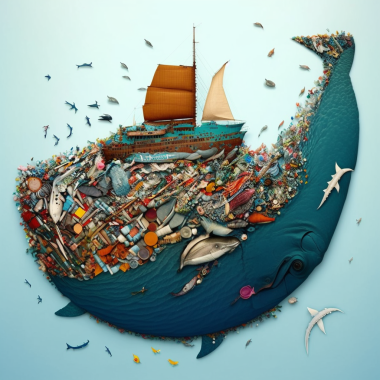
Introduction
Definition and location of The Great Pacific Garbage Patch The Great Pacific Garbage Patch (GPGP) is a large accumulation of marine debris, predominantly composed of plastics, floating in the North Pacific Ocean. The patch is located halfway between Hawaii and California, and it is estimated to be three times the size of France.
mportance of the topic The accumulation of plastic waste in the GPGP has become a major environmental concern, with serious consequences for marine life and the ecosystem. The topic has gained worldwide attention and has become an urgent call for action for governments, industries, and individuals.
The Size and Composition of the Garbage Patch
How it is measured The size and composition of the GPGP are difficult to estimate due to its constant movement and the presence of microplastics, which are not easily visible. However, researchers use a combination of visual surveys, nets, and modeling to estimate the size and composition of the patch.
Types of waste found in the patch The majority of the debris found in the GPGP is composed of plastics, including microplastics, macroplastics, and ghost nets. Other types of waste found in the patch include metals, rubber, and glass.

Effects on Marine Life and the Environment
Entanglement and ingestion The accumulation of plastic waste in the ocean poses a significant threat to marine life. Animals can become entangled in fishing nets or other debris, which can lead to injury or death. Ingestion of plastic waste is also a major concern, as it can cause choking, blockages, and internal injuries.
Effects on the food chain Plastic waste in the ocean can also have a significant impact on the food chain. As smaller organisms ingest plastic particles, the toxins in the plastic can accumulate in their bodies. As larger organisms consume these smaller organisms, the concentration of toxins can increase, posing a risk to human health as well.
Effects on the ecosystem The accumulation of plastic waste in the ocean can also have a broader impact on the ecosystem. As plastic waste sinks to the ocean floor, it can disrupt the natural balance of marine habitats and alter the composition of sediments.
Causes of The Great Pacific Garbage Patch
Plastic production and consumption The production and consumption of plastic have increased rapidly in recent years, leading to a significant increase in plastic waste in the ocean. Single-use plastics, such as plastic bags and water bottles, are a major contributor to the problem.
Improper waste disposal Improper waste disposal, including littering and inadequate waste management systems, is also a significant cause of the GPGP. Plastic waste that is not properly disposed of can end up in rivers and oceans, where it can accumulate over time.
Littering Littering, both intentional and unintentional, is also a major cause of plastic waste in the ocean. Many people do not realize that litter can easily end up in waterways, where it can be carried out to sea.

Solutions and Prevention
Reduce plastic consumption and production Reducing plastic consumption and production is an important step in preventing the accumulation of plastic waste in the ocean. Governments and industries can take steps to reduce plastic use, such as implementing bans on single-use plastics, promoting reusable items, and investing in alternative materials.
Proper waste management Proper waste management systems can also help prevent plastic waste from entering waterways and oceans. Governments and communities can invest in recycling programs, trash collection and disposal systems, and education and outreach campaigns to promote proper waste disposal.
Innovative solutions Innovative solutions are also being developed to address the problem of plastic waste in the ocean. For example, companies are developing technologies to capture and remove plastic waste from the ocean, and researchers are exploring the use of biodegradable plastics and alternative materials.
Conclusion
Recap of the problem The Great Pacific Garbage Patch is a massive accumulation of plastic waste in the ocean that poses a significant threat to marine life and the environment. The size and composition of the patch make it a difficult problem to address, but it is important to take action to prevent further damage.
Call to action Individuals, governments, and industries can all take steps to reduce plastic waste and prevent it from entering waterways and oceans. By working together, we can help to protect the health of the planet and its inhabitants.
